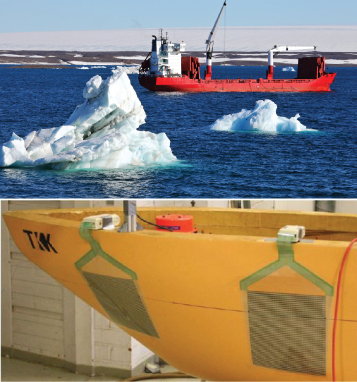Designing For the Challenging Voyage Ahead
 Figure 1: Pressure mapping sensors placed at the bow and bow shoulder of one of the ship models.
Figure 1: Pressure mapping sensors placed at the bow and bow shoulder of one of the ship models.
Challenge:
Cargo container ships can spend weeks at sea, and much of the time, far away from shore. Traveling through favorable water conditions comes with plenty of risks, but those risks are compounded when navigating through ice-bound shipping routes. Pressure distribution and impact data can help ship designers provide better support to certain weak zones on these vessels.
Solution:
Researchers with the Aalto University Department of Applied Mechanics, Marine Technology (Finland) recently employed pressure mapping technology to analyze ice crushing pressures on a ship’s hull during hull-ice interaction. A series of tests took place over four days in an ice tank, using two different ship models. Four pressure mapping sensors were positioned at different points of the hull to capture peak pressures.
As per their analysis, data captured in the model scale gave realistic pressure distributions for the ice induced loads in level ice conditions for various types of ships. Also, the researchers determined that the ice crushing pressures captured in the model analysis could be compared with full scale data. Furthermore, the findings suggested that mid-ship crushing pressures could be surprisingly high, especially when a ship has a high horse power.
Similar Applications:
- Understanding cargo shifts during flight
Source: Kujala, P. et. al. “Statistical Analysis of Ice Crushing Pressures on a Ship’s Hull During Hull-Ice Interaction” Cold Regions Science and Technology Journal 70 (2012) 1-11.
Choose Your Next Destination! Select From the Icons Below
